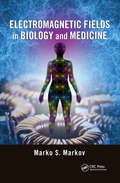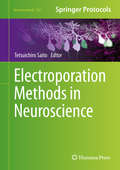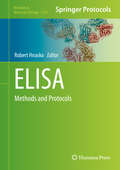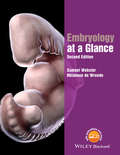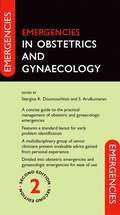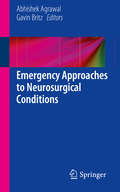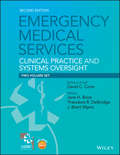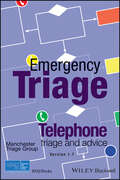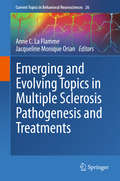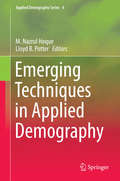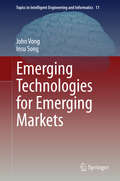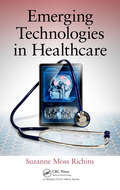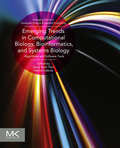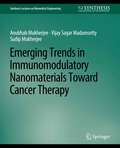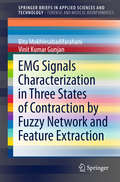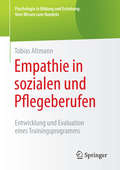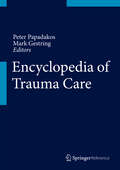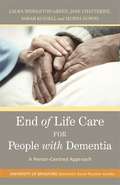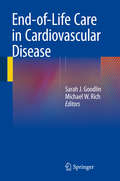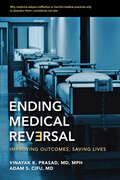- Table View
- List View
Electromagnetic Fields in Biology and Medicine
by Marko S. MarkovThrough a biophysical approach, Electromagnetic Fields in Biology and Medicine provides state-of-the-art knowledge on both the biological and therapeutic effects of Electromagnetic Fields (EMFs). The reader is guided through explanations of general problems related to the benefits and hazards of EMFs, step-by-step engineering processes, and basic r
Electroporation Methods in Neuroscience (Neuromethods #102)
by Tetsuichiro SaitoThis volume describes the methods of both in vivo and in vitro electroporation using ferrets, rats, mice, chickens, and zebrafish. Recent advances of experiments using the tetracycline-regulated gene expression and Tol2 transposon systems are also included. Written in the popular Neuromethods series style, chapters include the kind of detail and key advice from the specialists needed to get successful results in your own laboratory. Practical and authoritative, Electroporation Methods in Neuroscience serves to aid scientists in the further study into this crucially important way to study cells.
ELISA: Methods and Protocols (Methods in Molecular Biology #1318)
by Robert HnaskoThis volume is a practical biochemical guide to the Enzyme-Linked Immunosorbent Assay (ELISA), used to detect a target substance in a liquid sample. The ELISA is an important and widely used diagnostic tool in medicine, animal health, botany and quality assurance processes in food and beverage production. An introductory chapter orients the reader on the basic structure and function of immunoglobulins and their fragments while subsequent chapters outline the methodology to generate monoclonal antibodies using hybridoma technology and the general methods used to purify antibodies. Multiple chapters demonstrate how to creatively use the properties of the antibody to identify, localize and quantify target analytes to answer questions and resolve problems. The reader will learn how to use a variety of immunoassay strategies, reporters and detection systems that will undoubtedly facilitate their efforts to gain answers to their own questions. Written in the successful Methods in Molecular Biology series format, chapters include introductions to their respective topics, lists of the necessary materials and reagents, step-by-step, readily reproducible protocols and notes on troubleshooting and avoiding known pitfalls.Authoritative and easily accessible, ELISA: Methods and Protocols seeks to provide both professionals and novices with the technical information necessary for the reader to successfully use the immunoassay as part of the discovery process.
Embryology at a Glance (At a Glance)
by Samuel Webster Rhiannon de WreedeHighly Commended in Obstetrics and gynaecology in the 2017 BMA Medical Book AwardsEmbryology at a Glance is a highly illustrated and innovative introduction to key embryological concepts, with concise, memorable descriptions of major embryological developments. This new edition covers the basic principles of human development, from mitosis and meiosis, before exploring the primary formation of each body system, including the development of the musculoskeletal, circulatory, digestive, reproductive, and nervous systems during the foetal and neonatal periods. Key features include: New chapters on cell signalling genes, stem cells, and antenatal screening for common congenital and genetic defects Full colour photographs and illustrations Links to clinical practice highlighted throughout Timelines of each developmental stage MCQs and EMQs for revision and review A companion website at www.ataglanceseries.com/embryology featuring 15 brand new animations, and podcasts to help clearly explain the processes that occur during development. An additional instructor resource contains an image bank of all the figures from the book to aid teaching this fascinating area Embryology at a Glance provides the perfect alternative to the overwhelming detail seen in conventional embryology texts. It provides just the right level of detail on embryology and congenital abnormalities for all medical students and health professionals to develop a thorough understanding of human development and its implications for clinical practice.
Embryology at a Glance (At a Glance)
by Samuel Webster Rhiannon de WreedeHighly Commended in Obstetrics and gynaecology in the 2017 BMA Medical Book AwardsEmbryology at a Glance is a highly illustrated and innovative introduction to key embryological concepts, with concise, memorable descriptions of major embryological developments. This new edition covers the basic principles of human development, from mitosis and meiosis, before exploring the primary formation of each body system, including the development of the musculoskeletal, circulatory, digestive, reproductive, and nervous systems during the foetal and neonatal periods. Key features include: New chapters on cell signalling genes, stem cells, and antenatal screening for common congenital and genetic defects Full colour photographs and illustrations Links to clinical practice highlighted throughout Timelines of each developmental stage MCQs and EMQs for revision and review A companion website at www.ataglanceseries.com/embryology featuring 15 brand new animations, and podcasts to help clearly explain the processes that occur during development. An additional instructor resource contains an image bank of all the figures from the book to aid teaching this fascinating area Embryology at a Glance provides the perfect alternative to the overwhelming detail seen in conventional embryology texts. It provides just the right level of detail on embryology and congenital abnormalities for all medical students and health professionals to develop a thorough understanding of human development and its implications for clinical practice.
Emergencies in Obstetrics and Gynaecology (Emergencies in...)
by Stergios K. Doumouchtsis and S. ArulkumaranThe second edition of Emergencies in Obstetrics and Gynaecology provides a practical and accessible guide to all emergency situations encountered in obstetrics and gynaecology, from the immediately life-threatening to the smaller but urgent problems that may arise. Designed around the symptoms and signs with which the patient presents to the hospital, this handbook explains how to arrive at a differential diagnosis and how to prevent, manage, or treat an emergency. The 'Obstetric emergencies' section covers topics from early pregnancy through to post-delivery complications, whilst the 'Gynaecologic emergencies' section addresses those issues that could potentially pose a threat to a women's fertility or even her life. Addressing new topics on issues that have become more prevalent, such as substance misuse in pregnancy, and violence against women and children, the second edition of Emergencies in Obstetrics and Gynaecology is an essential read. A new topic on 'preoperative assessment' outlines how to manage consent, the risks, benefits, and what the patient should expect.
Emergency Approaches to Neurosurgical Conditions
by Abhishek Agrawal Gavin BritzPatients with neurosurgical conditions are almost always referred from either primary care physicians, neurologists, internist or a specialist in family medicine. This comprehensive guide will answer commonly asked questions about common neurosurgical conditions related to brain and spinal cord, in an attempt to fill in the gap and answer numerous questions that arises after a diagnosis is made on the loved ones. This book has been specially written and illustrated for families of patients undergoing neurosurgical procedures of the spine and peripheral nerve surgeries, as well as rehabilitation. It is straightforward, with non-technical language explaining the basics of neurosurgical diseases and their management including legal, ethical and financial issues.
Emergency Medical Services: Clinical Practice and Systems Oversight, 2 Volume Set
by David C. Cone Jane H. Brice Theodore R. Delbridge J. Brent MyersEmergency Medical Services: Clinical Practice and Systems Oversight is the official textbook of the National Association of EMS Physicians™ (NAEMSP™) National EMS Medical Directors Course and Practicum™. Now paired with a companion website featuring self-assessment exercises, audio and video clips of EMS best practices in action, and more, this essential study aid guides students through the core knowledge they need to successfully complete their training and begin their careers as EMS physicians. Emergency Medical Services: Clinical Practice and Systems Oversight consists of: Volume 1: Clinical Aspects of EMS Volume 2: Medical Oversight of EMS Companion website featuring supportive self-assessment exercises, audio and video clips
Emergency Medical Services: Clinical Practice and Systems Oversight, 2 Volume Set
by David Cone Jane H. Brice Theodore R. Delbridge J. Brent MyersEmergency Medical Services: Clinical Practice and Systems Oversight is the official textbook of the National Association of EMS Physicians™ (NAEMSP™) National EMS Medical Directors Course and Practicum™. Now paired with a companion website featuring self-assessment exercises, audio and video clips of EMS best practices in action, and more, this essential study aid guides students through the core knowledge they need to successfully complete their training and begin their careers as EMS physicians. Emergency Medical Services: Clinical Practice and Systems Oversight consists of: Volume 1: Clinical Aspects of EMS Volume 2: Medical Oversight of EMS Companion website featuring supportive self-assessment exercises, audio and video clips
Emergency Triage: Telephone Triage and Advice (Advanced Life Support Group)
by Advanced Life Support Group (ALSG)Emergency Triage: Telephone Triage and Advice complements the highly successful Emergency Triage. The algorithms are rooted in the Manchester Triage System (MTS), which is used in hospitals around the world and which is acknowledged as an effective means of clinical prioritisation. This telephone iteration of a triage system which prioritises millions of patients each year provides a robust, safe, evidence-based system for managing the clinical risk in patients who are at a distance from health care providers. The basic principles that drive the MTS remain, but this book addresses the specific difficulties of assessment by telephone. The possible triage outcomes are "face-to-face now", "face-to-face soon" and "face-to-face later" together with a self-care option. Information and advice is suggested at every level. The advice ranges from life-saving interventions, which can be carried out until health care arrives, to self-care instructions. Emergency Triage: Telephone Triage and Advice provides all the necessary information that telephone triage staff must have to hand as well as including examples of questions to be asked. It will be a valuable resource for staff working in emergency departments, health centres and telephone triage organisations. Furthermore hospitals that are already using Emergency Triage will benefit from being linked with a telephone triage system that follows the same protocols.
Emergency Triage: Telephone Triage and Advice (Advanced Life Support Group)
by Advanced Life Support Group (ALSG)Emergency Triage: Telephone Triage and Advice complements the highly successful Emergency Triage. The algorithms are rooted in the Manchester Triage System (MTS), which is used in hospitals around the world and which is acknowledged as an effective means of clinical prioritisation. This telephone iteration of a triage system which prioritises millions of patients each year provides a robust, safe, evidence-based system for managing the clinical risk in patients who are at a distance from health care providers. The basic principles that drive the MTS remain, but this book addresses the specific difficulties of assessment by telephone. The possible triage outcomes are "face-to-face now", "face-to-face soon" and "face-to-face later" together with a self-care option. Information and advice is suggested at every level. The advice ranges from life-saving interventions, which can be carried out until health care arrives, to self-care instructions. Emergency Triage: Telephone Triage and Advice provides all the necessary information that telephone triage staff must have to hand as well as including examples of questions to be asked. It will be a valuable resource for staff working in emergency departments, health centres and telephone triage organisations. Furthermore hospitals that are already using Emergency Triage will benefit from being linked with a telephone triage system that follows the same protocols.
Emerging and Evolving Topics in Multiple Sclerosis Pathogenesis and Treatments (Current Topics in Behavioral Neurosciences #26)
by Anne C. La Flamme Jacqueline Monique OrianOver the past decade, we have made great advances in the field of multiple sclerosis (MS) research, and this book focuses on those advances in MS pathogenesis and treatment. While some of these advances have been through new approaches and ideas that have emerged in the last decade such as the newly identified protective role that amyloid proteins may play in MS or the use of helminths to treat autoimmune diseases, others have evolved from previous theories and ideas that have only now gained momentum and a deeper understanding such as the role of HLA or gender in MS susceptibility. This book covers these emerging and evolving topics and highlights the substantial advancements made in elucidation of the factors regulating susceptibility or disease progression, identification of new ways to monitor or predict MS pathology, and development of new strategies for treating MS.
Emerging Techniques in Applied Demography (Applied Demography Series #4)
by M. Nazrul Hoque Lloyd B. PotterBy bringing together top-notch demographers, sociologists, economists, statisticians and public health specialists from Asia, Africa, Europe, and North America to examine a wide variety of public and private issues in applied demography, this book spans a wide range of topics. It evaluates population estimates and projections against actual census counts and suggests further improvement of estimates and projection techniques and evaluation procedures; new techniques are proposed for estimating families and households and particular attention is paid to the much-discussed topic of access to health care. Coverage extends to factors influencing health status and elder abuse, child bearing and labor market analysis and the effects of education on labor market outcomes of native white American and immigrant European populations.Methodologically rigorous and pragmatically useful, Emerging Techniques in Applied Demography also examines a wide variety of public and private issues under the field of applied demography. It provides a broad overview of research topics and also reflects substantial development in the field of applied demography. It also bridges the gap between theory and research by providing several examples of work of distinguished applied demographic.
Emerging Technologies for Emerging Markets (Topics in Intelligent Engineering and Informatics #11)
by John Vong Insu SongThis book introduces inclusive-cost-effective (ICE) approaches that have the potential to transform all aspects of daily lives of people at the base of the pyramid in the economic scale, who represent more than 75% of the world population. ICE means that the approaches must meet the affordability level at the base of the pyramid. This includes mobile banking and financial service technologies, mobile education, rural information and communication technologies, telemedicine, e-Health, and health social networks. This monograph is a compulsory reading for not only technology innovators, but also economists, social entrepreneurs, development specialists, health specialists, bankers and researchers and policy thinkers on technology and economic development.
Emerging Technologies in Healthcare
by Suzanne Moss RichinsRecent changes in healthcare delivery as mandated by the Patient Protection and Affordable Care Act are forcing providers to focus on technology as a way to improve the health of the population, while engaging patients and encouraging them to take accountability for maintaining their own health. One way of doing this is through the use of mobile he
Emerging Technologies in Healthcare
by Suzanne Moss RichinsRecent changes in healthcare delivery as mandated by the Patient Protection and Affordable Care Act are forcing providers to focus on technology as a way to improve the health of the population, while engaging patients and encouraging them to take accountability for maintaining their own health. One way of doing this is through the use of mobile he
Emerging Trends in Computational Biology, Bioinformatics, and Systems Biology: Algorithms and Software Tools (Emerging Trends in Computer Science and Applied Computing)
by Hamid R Arabnia Quoc Nam TranEmerging Trends in Computational Biology, Bioinformatics, and Systems Biology discusses the latest developments in all aspects of computational biology, bioinformatics, and systems biology and the application of data-analytics and algorithms, mathematical modeling, and simu- lation techniques. • Discusses the development and application of data-analytical and theoretical methods, mathematical modeling, and computational simulation techniques to the study of biological and behavioral systems, including applications in cancer research, computational intelligence and drug design, high-performance computing, and biology, as well as cloud and grid computing for the storage and access of big data sets. • Presents a systematic approach for storing, retrieving, organizing, and analyzing biological data using software tools with applications to general principles of DNA/RNA structure, bioinformatics and applications, genomes, protein structure, and modeling and classification, as well as microarray analysis. • Provides a systems biology perspective, including general guidelines and techniques for obtaining, integrating, and analyzing complex data sets from multiple experimental sources using computational tools and software. Topics covered include phenomics, genomics, epigenomics/epigenetics, metabolomics, cell cycle and checkpoint control, and systems biology and vaccination research. • Explains how to effectively harness the power of Big Data tools when data sets are so large and complex that it is difficult to process them using conventional database management systems or traditional data processing applications.Discusses the development and application of data-analytical and theoretical methods, mathematical modeling and computational simulation techniques to the study of biological and behavioral systems.Presents a systematic approach for storing, retrieving, organizing and analyzing biological data using software tools with applications. Provides a systems biology perspective including general guidelines and techniques for obtaining, integrating and analyzing complex data sets from multiple experimental sources using computational tools and software.
Emerging Trends in Immunomodulatory Nanomaterials Toward Cancer Therapy (Synthesis Lectures on Biomedical Engineering)
by Anubhab Mukherjee Vijay Sagar MadamsettyRecently, immunomodulatory nanomaterials have gained immense attention due to their involvement in the modulation of the body’s immune response to cancer therapy. This book highlights various immunomodulatory nanomaterials (including organic, polymer, inorganic, liposomes, viral, and protein nanoparticles) and their role in cancer therapy. Additionally, the mechanism of immunomodulation is reviewed in detail. Finally, the challenges of these therapies and their future outlook are discussed. We believe this book will be helpful to a broad community including students, researchers, educators, and industrialists.
EMG Signals Characterization in Three States of Contraction by Fuzzy Network and Feature Extraction (SpringerBriefs in Applied Sciences and Technology)
by Bita Mokhlesabadifarahani Vinit Kumar GunjanNeuro-muscular and musculoskeletal disorders and injuries highly affect the life style and the motion abilities of an individual. This brief highlights a systematic method for detection of the level of muscle power declining in musculoskeletal and Neuro-muscular disorders. The neuro-fuzzy system is trained with 70 percent of the recorded Electromyography (EMG) cut off window and then used for classification and modeling purposes. The neuro-fuzzy classifier is validated in comparison to some other well-known classifiers in classification of the recorded EMG signals with the three states of contractions corresponding to the extracted features. Different structures of the neuro-fuzzy classifier are also comparatively analyzed to find the optimum structure of the classifier used.
Empathie in sozialen und Pflegeberufen: Entwicklung und Evaluation eines Trainingsprogramms (Psychologie in Bildung und Erziehung: Vom Wissen zum Handeln)
by Tobias AltmannDas Buch stellt ein Konzept vor, das es Mitarbeitern in sozialen und Pflegeberufen erleichtert, mit ihrer Empathie bewusst umzugehen. Im Mittelpunkt der Analysen steht dabei das Trainingsprogramm „Mit Empathie arbeiten – gewaltfrei kommunizieren“, das einen reflektierten, authentischen und langfristig gesunden Umgang mit Empathie einübt. Das Buch fokussiert den Zusammenhang zwischen Empathie und daraus resultierenden Risiken wie Depressivität und Burnout, denen das Trainingsprogramm entgegenwirkt. Außerdem wird dessen Entwicklung beschrieben sowie eine Studie zu seiner Wirksamkeit vorgestellt.
End of Life Care for People with Dementia: A Person-Centred Approach
by Sarah Russell Murna Downs Laura Middleton-Green Jane ChatterjeePeople with dementia need increasingly specialised support as they approach the end of life, and so too do their families and the professionals working with them. This book describes not only what can be done to ensure maximum quality of life for those in the final stages of the illness, but also how best to support those involved in caring for them. Emphasising the importance of being attuned to the experiences and needs of the person with dementia, the authors explain why and how they should be included in decisions relating to their end of life care. Practical strategies for ensuring physical and emotional wellbeing are provided, drawing on useful examples from practice and providing solutions to potential challenges that carers and family members will face. Dilemmas surrounding end of life care are explored in detail, including the moral dilemma of medical intervention, and the authors suggest ways of supporting family members through the process in terms of providing information, helping them adjust to change and loss, and involving them in their relative's care, and at how care staff can be supported through appropriate education and training, team building and information-giving. This is an essential resource for anyone who wishes to provide compassionate, person-centred care for a person with dementia as they approach the end of life, including care staff, nurses, social workers and related professionals.
End of Life Care for People with Dementia: A Person-Centred Approach (PDF)
by Jane Chatterjee Laura Middleton-Green Murna Downs Sarah RussellPeople with dementia need increasingly specialised support as they approach the end of life, and so too do their families and the professionals working with them. This book describes not only what can be done to ensure maximum quality of life for those in the final stages of the illness, but also how best to support those involved in caring for them. Emphasising the importance of being attuned to the experiences and needs of the person with dementia, the authors explain why and how they should be included in decisions relating to their end of life care. Practical strategies for ensuring physical and emotional wellbeing are provided, drawing on useful examples from practice and providing solutions to potential challenges that carers and family members will face. Dilemmas surrounding end of life care are explored in detail, including the moral dilemma of medical intervention, and the authors suggest ways of supporting family members through the process in terms of providing information, helping them adjust to change and loss, and involving them in their relative's care, and at how care staff can be supported through appropriate education and training, team building and information-giving. This is an essential resource for anyone who wishes to provide compassionate, person-centred care for a person with dementia as they approach the end of life, including care staff, nurses, social workers and related professionals.
End-of-Life Care in Cardiovascular Disease
by Sarah J. Goodlin Michael W. RichEnd-of-life issues in cardiology are becoming increasingly important in the management of patients in the cardiac unit, but there is frequently a lack of understanding regarding their impact on cardiology practice. The cardiac unit is increasingly becoming the location whereby a number of key clinical decisions relating to end-of-life care are being made, such as the decision to remove medications, the appropriate removal of cardiac devices, the management of do not resuscitate orders and the requirement for other cardiac procedures in light of the management of the terminally ill cardiac patients. Those working in palliative care need input from the cardiovascular team as the cardiologist is frequently still managing these patients until they are moved to the hospice. That this move into a hospice is often delayed until the very last moment, there is considerable onus on the cardiovascular management of these patients to be much broader in scope and take account of some of the more palliative medical decisions needed in this group of patients. This concise reference will detail the practical issues open to cardiovascular physicians and those medical professionals who manage patients reaching the end of their life from a cardiology perspective. It will detail the full management options open to them to ensure that their practice is in line with the requirements of the patient nearing the end of their life whether the cause be cardiovascular in origin or who need appropriate management of secondary cardiovascular symptoms. It will also include the various ethical, cultural and geographical issues that need to be considered when managing these patients.
Ending Medical Reversal: Improving Outcomes, Saving Lives (A Johns Hopkins Press Health Book)
by Vinayak K. Prasad Adam S. CifuMedications such as Vioxx and procedures such as vertebroplasty for back pain are among the medical "advances" that turned out to be dangerous or useless. What Dr. Vinayak K. Prasad and Dr. Adam S. Cifu call medical reversal happens when doctors start using a medication, procedure, or diagnostic tool without a robust evidence base;¢;‚¬;€?and then stop using it when it is found not to help, or even to harm, patients.In Ending Medical Reversal, Drs. Prasad and Cifu narrate fascinating stories from every corner of medicine to explore why medical reversals occur, how they are harmful, and what can be done to avoid them. They explore the difference between medical innovations that improve care and those that only appear to be promising. They also outline a comprehensive plan to reform medical education, research funding and protocols, and the process for approving new drugs that will ensure that more of what gets done in doctors' offices and hospitals is truly effective.
